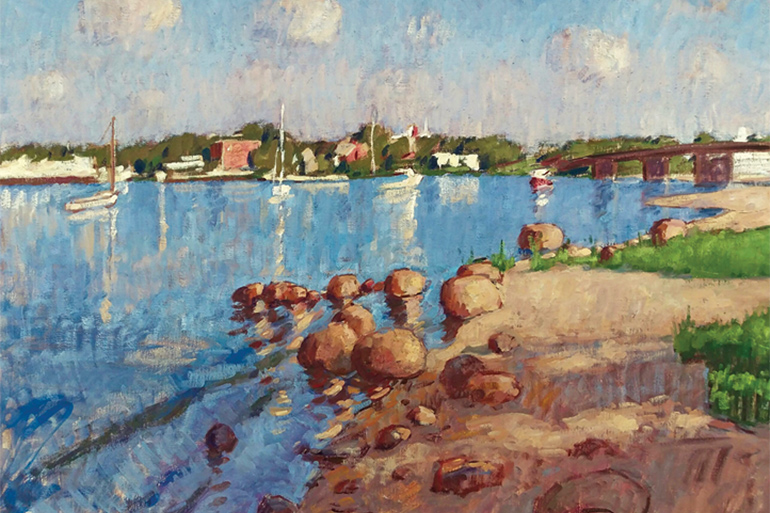Dan's Papers Cover Artist Timothy McGuire Paints a Sag Harbor Scene

This week’s cover artist, Timothy McGuire, is originally from Buffalo and currently a resident of Nova Scotia. A landscape, portrait, still life and figure painter, McGuire works primarily in oil. McGuire’s career also includes teaching fledgling artists.
What was the inspiration for this painting?
This painting is a view of Sag Harbor, and the Sag Harbor-North Haven Bridge leading into it from a spot in North Haven where I’ve literally never seen another human being. It’s a place of solitude in an otherwise bustling small town. I painted it in the late afternoon/early evening late last summer. The inspiration came from the long shadows from that time of day, as they lay upon the sand, reaching over the rocks and boulders and into the calm, cool waters. I paint from life, always, and to be there at that spot, seeing the village from a distance, while I’m immersed in quiet solitude with blue and pink colors all around while the sand grows cool under my feet—there’s nothing else like it. I find it all very inspiring.
How did you get started in art?
When I was a kindergartener at Our Lady of Lourdes back in Utica, my teacher, Mrs. Oaster, looked at a drawing I was doing and said to me, “You’re going to be an artist one day, aren’t you?” I just looked at her and said, “Uh-huh!” All my life I’ve been drawing and painting. But when it came time for university, I studied elementary education. I taught kindergarten in California for 10 years. But during that time, I started to get more interested in drawing and painting.
I crashed the figure drawing classes at Long Beach State and with strong encouragement from Sharon McNeil, my teacher at the time, I sought out a solid foundation in drawing and painting. I found it at the Florence Academy of Art in Italy. I studied there for a little over three years, and continued living in Florence for over a decade. The initial training I got at the Florence Academy, and the encouragement I received from the director of the school, Dan Graves, gave me the confidence to pursue my own vision—to take what they gave me and turn it into something truly my own.
How would you describe your art style?
Like I said, I always paint from life. That is to say, I never use photographs. I’ve never wanted to, and I’ve never tried. But still, I paint in a style that is representational and could broadly fit in the category of ‘realism.’ In the end, I think my work has more in common with abstract art than realist art in the sense that it’s the beauty of abstract shapes, the way they intertwine and tangle themselves into a cohesive image that really interests me. It’s what I try to look for in nature and then translate into brush strokes of different colors and shapes. Standing back, far away from the painting, that’s when it comes together to form a complete visual impression.
What was it like studying in Florence?
Studying in Florence was incredible—often difficult and very trying, but in the end, so rewarding. The Florence Academy of Art is not a vocational school—one doesn’t go there for three years and come out having a learned the trade of painting. Rather, it’s an experience in which one can become fully immersed in art for several years. You accept what they have to offer, apply yourself, dedicate yourself fully to the training, and in the end, find your own voice.
While there, studying lines, shapes, and colors, I was often reminded of teaching letters, sounds, and words to my kindergartners back in California; these are like Lego, the basic building blocks from which anything can be created. My education at The Florence Academy of Art was like that—very basic, but also full of potential.
How has teaching art to others helped you grow as an artist?
I organize a plein air workshop in Italy every year. This year we’re going in early October. I’ll also have something along those lines going on in the East End mid-July. During these workshops, I do demos, as well as teach each painter individually, giving personal critiques several times throughout the day. This is an approach I learned as a student teacher in Florence. While I was a student at the Florence Academy of Art, I was honored to be asked to teach other students, as well.
The director told me the school wanted me to teach, not for my painting skills, but for my skills as a teacher. “Great!” I thought, “I guess my painting skills need to improve!” And from day one as a student teacher, they did! My own work started to improve as I heard myself speak to others the very words I, myself, needed to hear. This was very valuable. I’ve also seen countless times when students continue to work on their paintings for a lot longer than they should. The trick is to know when to take the painting away from them—before they have a chance to paint the life out of it! Well, the same goes for me. By teaching others, I’ve learned to tell myself when to stop working before it’s too late!
Where do you get inspiration for your work?
I find inspiration literally everywhere. The world in which we live is so visually interesting. Most days, the difficulty lies in selecting just one idea from the myriad presented all around. As I investigate a subject, sketching and studying the composition, figuring out the theme, the color and shape relationships, I become more and more inspired.
As I proceed, the thrill of creating takes over and the more I pour myself into my work, the more it gives back to me. I also find inspiration in looking at the work of the great painters who have come before me. I always go to the Met whenever I come out to NY. And I can’t leave Strand without an armful of new art books. Last time, it was books featuring the Pennsylvania Impressionists, particularly William Langson Lathrop and George Sotter.
Timothy McGuire’s work can currently be seen at the Grenning Gallery in Sag Harbor. For more on McGuire and his work, visit timothyandrewmcguire.com.




